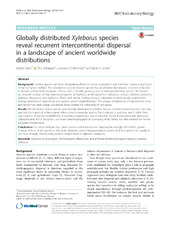| dc.description.abstract | Background: Invasive species can have devastating effects on native ecosystems and therefore impose a significant threat to human welfare. The introduction rate of invasive species has accelerated dramatically in recent times due to human activity (anthropogenic effects), with a steadily growing pool of widespread tramp species. We present an in-depth analysis of four pantropical species of Xyleborus ambrosia beetles (Xyleborus volvulus, Xyleborus perforans, Xyleborus ferrugineus, and Xyleborus affinis) with similar ecology (fungus cultivation in dead wood), reproductive biology (permanent inbreeding) and genetic system (haplodiploidy). The unique combination of reproductive traits and broad host plant usage pre-adapts these beetles for colonizing of new areas. Results: We found that all four species were broadly distributed long before human-assisted dispersal became common, and that the impact of anthropogenic effects varied among the species. For X. volvulus, X. perforans, and X. affinis there was evidence of ancient establishment in numerous regions, but also of abundant recent introductions into previously colonized areas. For X. ferrugineus, we found clear biogeographical structuring of old clades, but little evidence for recent successful introductions. Conclusions: Our results indicate that current human-aided transoceanic dispersal has strongly affected the genetic makeup of three of the species in this study. However, current biogeographical patterns of all four species are equally, if not more strongly, influenced by ancient establishment on different continents | en_US |

